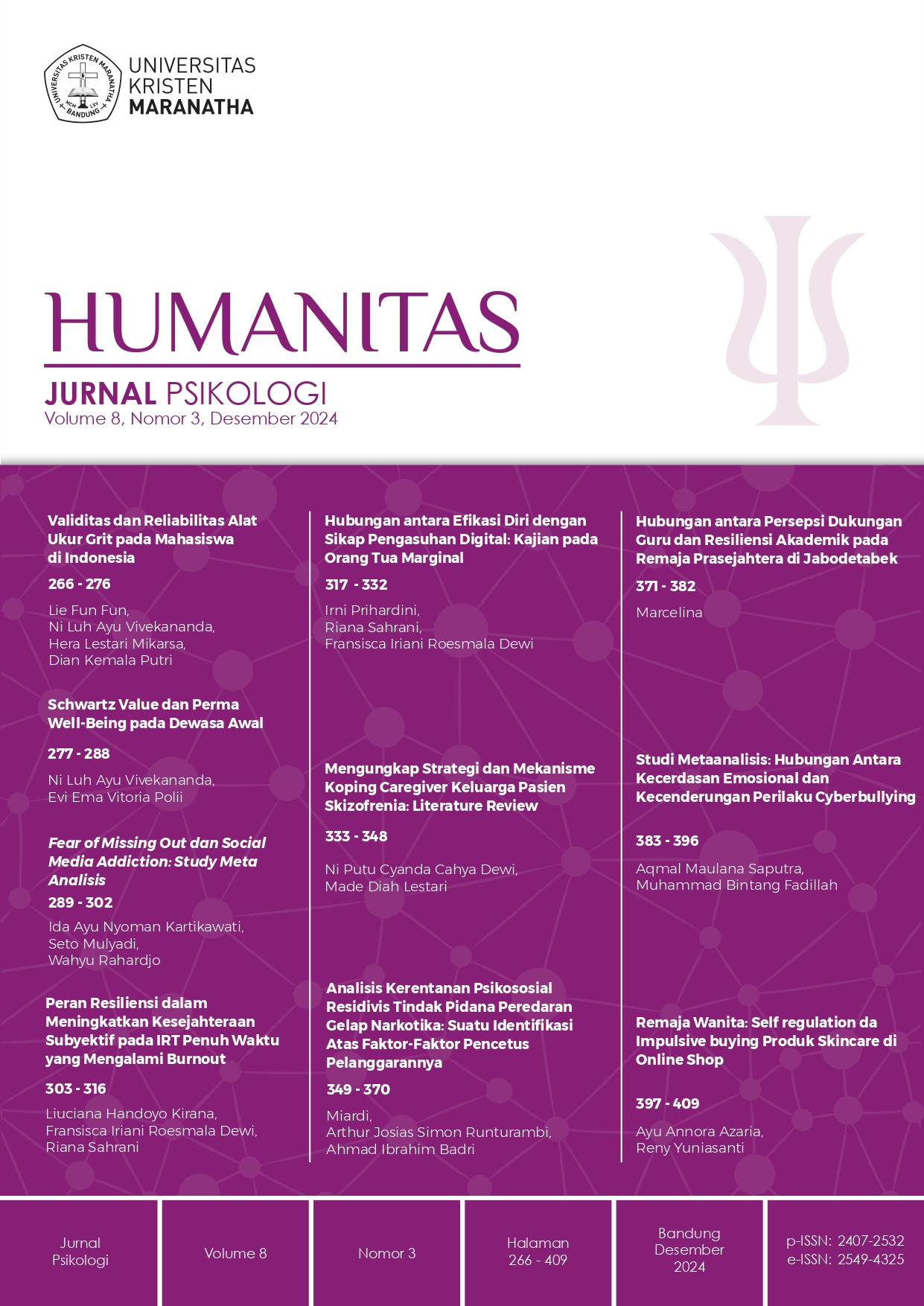Analysis of Psychosocial Vulnerability of Recidivists In The Criminal Act of Illegal Drug Distribution
Main Article Content
Abstract
Downloads
Article Details

This work is licensed under a Creative Commons Attribution-NonCommercial 4.0 International License.
References
Albanese. (2014). Organized Crime in Our Times. Routledge Taylor & Francis for The International Institute for Strategic Studies. https://www.taylorfrancis.com/books/mono/10.4324/9781315721460/organized-crime-times-jay-albanese
Baron, S. W. (2015). Differential Social Support, Differential Coercion, and Organized Criminal Activities. Justice Quarterly, 32(6), 1089–1117. https://doi.org/10.1080/07418825.2014.887760
Benisty, M. (2022). Familial Spin: A Criminal Spin Theory Perspective on the Experiences of Parents and Siblings of Incarcerated Men. Victims and Offenders, 17(4), 513–527. https://doi.org/10.1080/15564886.2021.1967241
BNN RI. (2019). Petunjuk Teknis Indeks Keterpulihan Kawasan rawan Narkoba. Deputi Pemberdayaan Masyarakat BNN RI.
BPS Kabupaten Deli Serdang. (2023). Kecamatan Percut Sei Tuan Dalam Angka Percut Sei Tuan Subdistrict in Figures 2023 (Issue 112).
Calderoni, F., Campedelli, G. M., Szekely, A., Paolucci, M., & Andrighetto, G. (2022). Recruitment into Organized Crime: An Agent-Based Approach Testing the Impact of Different Policies. Journal of Quantitative Criminology, 38(1), 197–237. https://doi.org/10.1007/s10940-020-09489-z
Canter, D. (2010). Forensic Psychology; A Very Short Introduction (1st ed.). Oxford University Press.
Direktorat Jenderal Pemasyarakatan. (2021). NOMOR : PAS-90.KP.04.01 TAHUN 2021 TENTANG RENCANA STRATEGIS DIREKTORAT JENDERAL PEMASYARAKATAN TAHUN 2020-2024. In Kementerian Hukum dan HAM Republik Indonesia (Nomor: PAS-90.KP.04.01 Tahun 2021).
Ditjenpas. (2024). Data Warehouse Tindak Pidana Khusus. Ditjenpas.Go.Id. https://sdppublik.ditjenpas.go.id/dwh/pidana_khusus
Duncan, J. M., Betsy Garrison, M. E., Killian, T. S., Moon, Z. K., & Way, K. A. (2022). Family Resilience: Variations by Individual Psychological and Health Resources, Social Capital and Sociodemographic Characteristics. The Family Journal, 30(3), 376–383. https://doi.org/10.1177/10664807211061825
Gadd, D., & Jefferson, T. (2007). Psychosocial Criminology (First). SAGE Publications.
Gerungan, W. A. (2010). Psikologi Sosial (J. Budhi (ed.); 3 Cetakan). Refika Aditama.
Hagan, F. (2013). Pengantar Kriminologi; Teori, Metode, dan Perilaku Kriminal (A. Anwar (ed.); Edisi Ketu).
Hanita, M. (2020). Ketahanan Nasional; Teori, Adaptasi dan Strategi (Surya W (ed.); Edisi Keti). UI Publishing.
Henry, C. S., Sheffield Morris, A., & Harrist, A. W. (2015). Family Resilience: Moving into the Third Wave. Family Relations, 64(1), 22–43. https://doi.org/10.1111/fare.12106
Hollway, W. (2013). Locating Unconscious, “Societal-collective” Processes in Psycho-social Research. Organisational and Social Dynamics, 13(1), 22–40, 110.
Kemenkumham RI. (2024). Data Residivis. https://sada.kemenkumham.go.id/datasets/residivis
Kleemans. (2014). Theoretical Perspectives on Organized Crime. The Oxford Handbook of Organized Crime, 32–52.
Kolak, M. A., Chen, Y. T., Joyce, S., Ellis, K., Defever, K., McLuckie, C., Friedman, S., & Pho, M. T. (2020). Rural risk environments, opioid-related overdose, and infectious diseases: A multidimensional, spatial perspective. International Journal of Drug Policy, 85(June 2020), 102727. https://doi.org/10.1016/j.drugpo.2020.102727
Leong, K., Li, H., Rysman, M., & Walsh, C. (2022). Law Enforcement and Bargaining over Illicit Drug Prices: Structural Evidence from a Gang’s Ledger. Journal of the European Economic Association, 20(3), 1198–1230. https://doi.org/10.1093/jeea/jvac003
Maloku, A. (2020). Theory of differential association. Academic Journal of Interdisciplinary Studies, 9(1), 170–178. https://doi.org/10.36941/ajis-2020-0015
Naser, R. L., & La Vigne, N. G. (2006). Family support in the prisoner reentry process: Expectations and realities. Journal of Offender Rehabilitation, 43(1), 93–106. https://doi.org/10.1300/J076v43n01_05
Prendergast, M. L. (2006). Intervensi untuk Mendorong Keberhasilan Masuk Kembali di Antara Para Pembebasan Bersyarat Penyalahguna Narkoba. 4–22.
Rafiee, G., Ahmadi, J., & Rafiee, F. (2020). Prevalence of Substance Abuse (Tobacco, Alcohol, Narcotics and Psychotropic Drugs) and Its Relationship to Family Factors in Pre-university Male Students in Shiraz 2017–2018. Journal of Community Health, 45(1), 176–182. https://doi.org/10.1007/s10900-019-00709-7
Sbraccia, A. (2018). Pengulangan kejahatan : Perspektif Teoritis dan Penelitian Kualitatif Residivisme : Perspektif Teoretis dan Penelitian Kualitatif. 2(April).
Shuja, & Hamza, K. (2022). Criminal Recidivism in Pakistan : A Grounded Theory of Social & Criminal Recidivism in Pakistan : A Grounded Theory of Social & Environmental Causes and Psychological Consequences. September. https://doi.org/10.53107/nnjp.v2i2.6
Sousa, S., Cardoso, J., & Cunha, P. (2024). Risk and protective factors in criminal recidivist inmates. Annals of Medicine, 51(sup1), 184–184. https://doi.org/10.1080/07853890.2018.1562754
UNODC. (2012). Introductory Handbook on the Prevention of Recidivism and the Social Reintegration of Offenders. Criminal Justice Series, 11.
Unu, L. M., & Yulahap, A. (2021). Kajian faktor dominan pada residivis penyalahgunaan narkotika di lembaga pemasyarakatan narkotika kelas II A doyo jayapura. Jurnal Pemberdayaan Masyarakat Papua (JPMP), 2(1), 31–43.
Vignaendra, S., Viravong, A., Beard, G., & McGrath, A. (2011). Reducing Juvenile Reoffending by Understanding Factors Contributing to Intention to Reoffend. Current Issues in Criminal Justice, 22(3), 433–455. https://doi.org/10.1080/10345329.2011.12035897
West, R., & Brown, J. (2013). Addiction in populations, and comprehensive theories. Theory of Addiction, 136–151. https://doi.org/10.1002/9781118484890.ch6
Yin RK. (2009). Case Study h Researc Design and Methods. Fourth Edition. In Applied Social Research Methods Seiries (Vol. 5). http://cemusstudent.se/wp-content/uploads/2012/02/YIN_K_ROBERT-1.pdf%5CnISBN 978-1-412296099-1
Zhu, P., Wu, Q., Waidley, E., Ji, Q., & Qian, M. (2023). Family resilience in a crisis: A qualitative study of family resilience in multimember infected families in the context of COVID-19. Psychological Trauma: Theory, Research, Practice, and Policy. https://doi.org/10.1037/tra0001547

